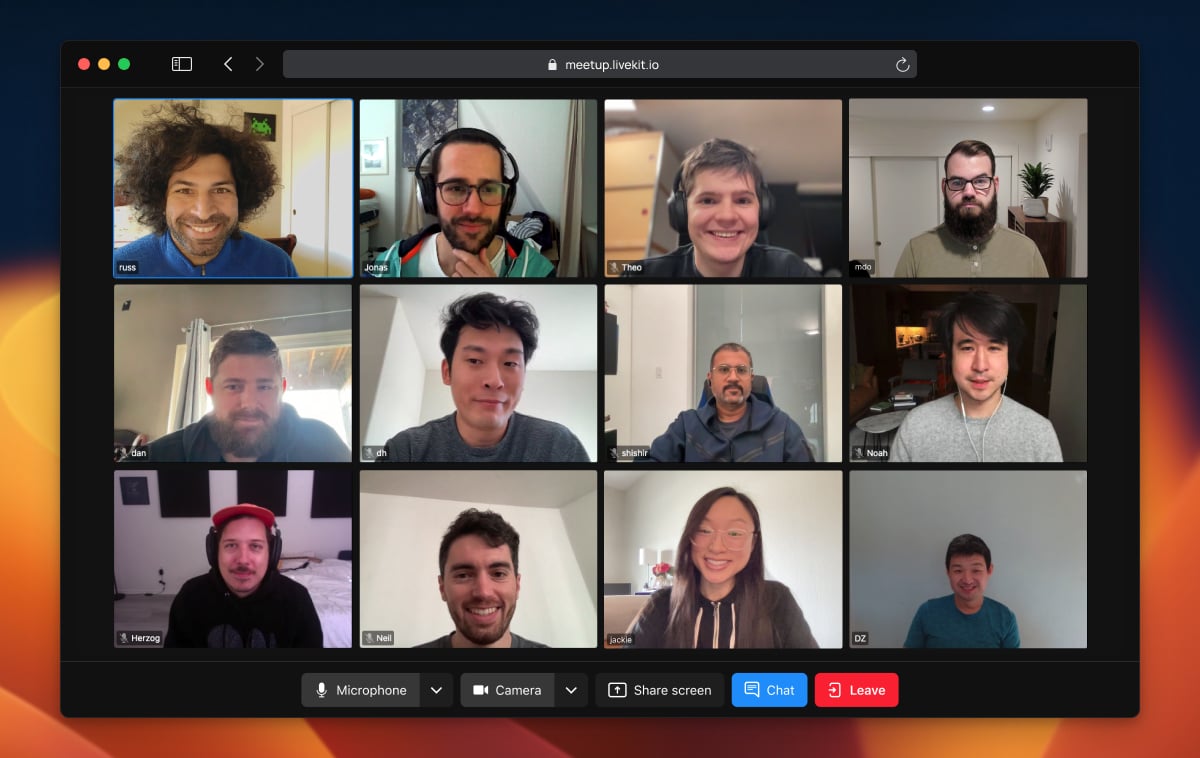
Disclaimer — This is project is in active development and open sourced as a developer preview. While APIs are unlikely to drastically change from here onwards, there's still the chance that some things might need tweaking after an update. We appreciate feedback from the community and are planning to incorporate your feedback to get to a stable version as soon as possible!
Create your LiveKit WebRTC experience without worrying about state. LiveKit Components give you a declarative way to build your real-time LiveKit audio/video frontend with React.
Every use case is different and apps in the real world are individual and unique. We don't pretend to have the perfect solution that fits all use cases. Instead, we've taken an approach where we give you reasonable defaults, without taking away full control over each component if you want it.
You don't have to worry about participant or room events to update the state of your application. All components handle state management for you, and by using React contexts, you don't have to route properties through your component tree.
We offer all the necessary building blocks to build a live video or audio app in no time.
We put a lot of effort into creating components that work and look great right out of the gate. Get started quickly by using the defaults of your components or overwrite them by simply adding children.
//1️⃣ Use the components defaults to render a video conference app
<LiveKitRoom token="my-token" serverUrl="wss://my-livekit-server" connect={true} >
<VideoConference />
</LiveKitRoom>
// 2️⃣ or overwrite the defaults with your custom component tree.
<LiveKitRoom >
<ParticipantLoop>
{/* */}
</ParticipantLoop>
</LiveKitRoom>Because most of the components are merely wrappers around standard HTML-Elements you can overwrite the basic component style how ever you want.
On top of that we provide a handful of pre-defined css variables to easily theme LiveKit Components to your needs.
To add styling from our @livekit/components-styles package:
Import all styles including the default theme
import '@livekit/components-styles';And add a theme data attribute to the <LiveKitRoom/> or any HTML container, to gain access to default LiveKit styles.
<div data-lk-theme="default"...The component we offer does not fit your requirements? We have the solution for you! Each component comes with its own React hook that allows you to create your own component with minimal boilerplate. Of course, you can also combine your own component with our pre-built components. It's common to start with our components to quickly sketch out a concept, and then replace some of them with your own components to build something we could never have imagined.
The best way to get started is to use the @livekit/components-react package and install it.
yarn add @livekit/components-react livekit-clientor
npm install @livekit/components-react livekit-clientCreating a full fledged video conference is as easy as
import { LiveKitRoom, VideoConference } from '@livekit/components-react';
export function App() {
return (
<LiveKitRoom token="<livekit-token>" serverUrl="<url-to-livekit-server>" connect={true}>
<VideoConference />
</LiveKitRoom>
);
}There are some basic example on how to use and customize LiveKit Components in the nextjs example folder
In order to set the examples up locally follow the development guide.
We also have a fully featured video conferencing application built on top of LiveKit Components here that powers https://meet.livekit.io.
By abstracting most of the state handling logic into a common core we wanted to make sure that other framework implementations can be created with minimal code duplication. We chose observables as the main data structure for this core as its concepts translate really well to for example React's hooks, solid's signals, Svelte's stores, Vue's composables, and angular loves observables out of the box.
Yes, we did consider building LK Components with custom elements (web components). We ultimately decided against it in order to give users the option to develop within the constraints of their chosen framework with all its specific concepts (e.g. in the case of react hooks, context etc.). That said the road towards supporting custom elements isn't entirely closed off. If the adoption of custom elements gains traction we can imagine providing a framework implementation that additionally compiles to custom elements (e.g. solid or svelte).
The highest priority is currently to get the core and react packages to a stable version that people love to work with. Once this is done we will decide on what other frameworks we might to support officially. If you want to develop an implementation for your favorite framework based on the core package we'd love to talk to you about it!
This repo consists of multiple packages that partly build on top of each other. It relies on yarn workspaces and Turborepo (which gets installed automatically).
On the root level:
yarn installIn order to link up initial dependencies and check whether everything has installed correctly run
yarn buildThis will build all the packages in /packages and the examples in /examples once.
After that you can use a more granular command to only rebuild the packages you are working on. E.g. to test and automatically rebuild package dependencies for the nextjs example, run:
yarn dev:nextNote for the examples to work you'll need to make sure to copy the the contents of .env.example in the specific example folder to a newly created .env.local file and adjust the values accordingly to your livekit server setup.
- Home 👈
- Docs
- Framework Implementations:
- Examples
- Internal Packages
| LiveKit Ecosystem | |
|---|---|
| Core Infra | livekit · egress · ingress · livekit-cli |
| Client SDKs | Components · JavaScript · Rust · iOS/macOS · Android · Flutter · Unity (web) · React Native (beta) |
| Server SDKs | Node.js · Golang · Ruby · Java/Kotlin |
